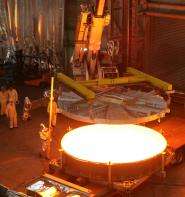UA to shape solar telescope mirror

(PhysOrg.com) -- When finished, the 4.2-meter mirror will be the largest telescope mirror ever pointed at the sun. Polished into a highly complex, asymmetric shape, it will be the centerpiece of the Advanced Technology Solar Telescope in Hawaii, allowing researchers to study the sun in unprecedented detail.
The University of Arizona's College of Optical Sciences has been awarded a multi-million dollar contract by the Association of Universities for Research in Astronomy, or AURA, to polish the 4.2-meter primary mirror for the Advanced Technology Solar Telescope, or ATST.
When operational in Hawaii, the ATST will become the world's largest solar telescope. This glass mirror will serve as the primary focusing element to create high-resolution images of the fine scale structure of the sun.
The large size and precision of the mirror will allow the telescope to provide data that helps scientists to address basic questions of solar magnetism and how its changing outputs affect the Earth. The mirror blank is being fabricated under contract with SCHOTT North America at the SCHOTT facility in Mainz, Germany.
The mirror itself will be 14 feet (4.2 meters) in diameter and only 3 inches (75 millimeters) thick at the thinnest point, making it twice as flexible as a similarly sized mirror polished at the College of Optical Sciences for the Discovery Channel Telescope in Flagstaff, Ariz.
The project, led by James H. Burge, professor of astronomy and of optical sciences, and Martin Valente, director of the Optical Fabrication and Engineering Facility, utilizes advanced technologies developed at the UA for polishing large ultra-precise mirrors and for measuring shape errors of complex mirrors with high precision.
The new telescope uses an off-axis design, which requires the finished surface of the primary mirror to be the shape of an off-axis paraboloid, which complicates the polishing process and measurement systems.

"To visualize this shape, picture a bucket of water hanging on a rope," Burge said. "If you were to spin this bucket around, you could watch the water rise along the sides while a depression forms in the center. The resulting shape is called a paraboloid, which happens to be the typical geometrical shape underlying telescope mirror designs."
In the case of the ATST mirror, Burge's team will face an even more complex task polishing it in such a way that its surface assumes a so-called off-axis paraboloid. Conceptually, this shape can be thought of as a smaller mirror cut out from the edge of a larger, parent paraboloid mirror, except that the real mirror will not be cut out from a larger parent but made into this complex, asymmetric shape from the beginning.
"The UA is the pre-eminent place to take on very difficult projects like this mirror," Burge said. "Our excellence in optical engineering allows us to attract the best students and the best faculty. Our students will participate in research that supports the project, and they will learn firsthand how such a complex and large project is run from beginning to completion."
The UA is internationally renowned for developing and implementing technologies that enable production of the world's most challenging mirrors. The technology advancements required for manufacturing and testing the ATST mirror leverages some of the key technologies that are already in use at the UA's Steward Observatory Mirror Laboratory for the Giant Magellan Telescope.
The UA was selected by AURA for this work based on a competitive process. Nearly all of the funding will be spent in Arizona. This contract will enable Burge's team to invest in project-related, state-of-the-art facilities at the College of Optical Sciences and will allow UA students to hone practical research and engineering skills while contributing to one of the nation's most prized scientific assets.
Provided by University of Arizona


















